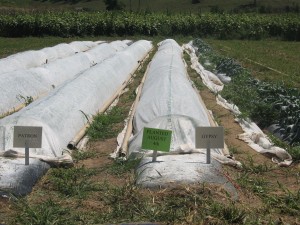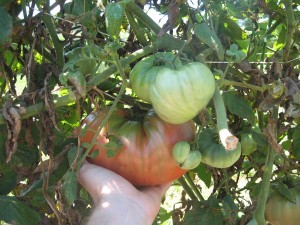The third section of the workshop sprouted something unusual in the field–nervous laughter.
“Now, since this is a workshop,” said Dr. Davis as she pointed behind her to four swimming pool length rows of broccoli,”We’re actually going to make all of you…do some work.”
The broccoli Davis pointed to is part of a multi-million dollar multi-state grant provided to several schools (including the research station) to start the first ever East Coast fall broccoli provider (thus the name of the third act, “Fall broccoli production opportunities and challenges”).
Our job consisted of an unveiling of one row to demonstrate the effectiveness of a simple reemay cover against loathsome flea beetles. Davis lamented on how other organic pesticides (pyrethrin, neem oil) had little effect on the bugs (pictures from several weeks before showed Swiss cheese holes in the plant). A gasp swirled around the crowd when the cover lifted revealing a sturdy row of intact leaves. White paint covered the black plastic mulch to reflect unwanted heat.

The final and most fascinating piece could turn mild mannered gardeners and farmers into lofty dirt scientists. Grafting Tomatoes–hosted by Dr. Frank Louws–consists of taking tomato cultivars known for resistance to soil borne pathogens (with Louws concentrating on bacterial wilt and fusarium wilt) and combining them with a high fruit quality tomato like a German Johnson. The soil resistors are known as the rootstock, and the above ground beauties are known as the scions.
After germination, the rootstock and scion are grafted together. The top part of the rootstock is severed at a 45 degree angle. The bottom is united with the top part of the scion (also severed) by rubber tube shaped grafts.
This grafting model provides promise in the future for organic farmers who would like to see their yields go up, while their crop disease plummets. (For a detailed report on grafting, go to Dr. Louws’ and Cary Rivard’s report on Tomato Grafting).
Science folded in favor of lunch. All guest were taken back up to the lodge (complete with a good old fashioned hay-style ride) and treated to mounds of fresh heirlooms, bread, mayo (of course), and sides. Folks then owned the option of doing taste tests and rating the organic tomatoes displayed in the fields.

Once the bellies were satisfied, Bernstein queried the crowd on the best names for the new organic research project. Participants were also encouraged to come up with their own organic research recommendations as well as visit some of the sponsors at their tables.
Bernstein summed up the event in the four words after encouraging attendees to contact the powers to be to keep things like organic research ongoing.
“This belongs to you!” she said.
It certainly does.

Leave a Reply